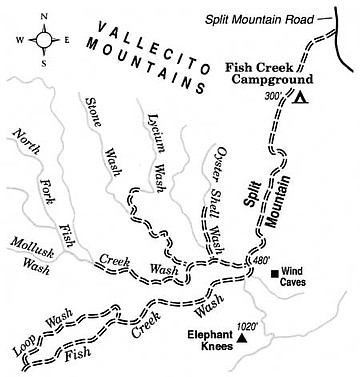 Facebook
Facebook
 X
X
 Instagram
Instagram
 TikTok
TikTok
 Youtube
Youtube
Deep in the corrugated folds of Anza-Borrego's Carrizo Badlands, a trio of sinuous dry washes invites your slow and careful exploration -- first by truck or 4-wheel drive, and then by foot. Here, on the lower margin of the upthrust Vallecito Mountains, accumulated sediments dating back millions of years have been forced upward, tilted, and severely eroded.
Follow Highway 78 east to Ocotillo Wells, turn south on Split Mountain Road, and continue eight miles to the Split Mountain turnoff (Fish Creek wash, threaded by wheel tracks in the sand) on the right. After nearly two miles, you enter Split Mountain, where Fish Creek has carved a narrow gorge between sheer rock walls. The gorge walls reveal layer-cake strata reflecting successive periods of invasion by the sea and reclaiming by the land. The primitive road ahead is sometimes blocked by slides or rendered impassable by heavy rain; it is definitely not recommended for low-slung passenger cars.
After 2.5 miles, when the gorge walls fully part, bear right (west) on the sandy road along the North Fork of Fish Creek wash. Continue through a landscape dominated by clay hills (also called "mud hills" for their consistency when wet) strewn with sparkling chips of gypsum crystal. Just ahead lie the three dry washes of interest -- each with its own character. Oyster Shell Wash, in its upper end, features water-polished, fossil-bearing sandstone walls and shallow depressions sometimes filled with water. Lycium Wash, threaded by a 2.5-mile-long spur road, is named after the shrub Lycium, or boxthorn, which flourishes hereabouts and blooms circumspectly in early spring. Beyond the road end, some semi-challenging scrambling on foot will take you farther up Lycium Wash -- past a narrow trench, over tilted layers of sandstone, up and over three low "dry falls," and finally past a big, boulder-choked defile. After all this, a less breathless ascent leads to the crest of the Vallecito Mountains, offering a fine view in nearly every direction.
Finally, for serious rock scramblers only, there's Stone Wash, a west tributary of Lycium Wash. Floodwaters in the bottom of this drainage have carved several steep chutes into conglomerate rock -- a sedimentary rock made of large and small bits of rock cemented together. The abundant protruding rocks in the chutes provide enough handholds and footholds to facilitate a painstaking passage.


Deep in the corrugated folds of Anza-Borrego's Carrizo Badlands, a trio of sinuous dry washes invites your slow and careful exploration -- first by truck or 4-wheel drive, and then by foot. Here, on the lower margin of the upthrust Vallecito Mountains, accumulated sediments dating back millions of years have been forced upward, tilted, and severely eroded.
Follow Highway 78 east to Ocotillo Wells, turn south on Split Mountain Road, and continue eight miles to the Split Mountain turnoff (Fish Creek wash, threaded by wheel tracks in the sand) on the right. After nearly two miles, you enter Split Mountain, where Fish Creek has carved a narrow gorge between sheer rock walls. The gorge walls reveal layer-cake strata reflecting successive periods of invasion by the sea and reclaiming by the land. The primitive road ahead is sometimes blocked by slides or rendered impassable by heavy rain; it is definitely not recommended for low-slung passenger cars.
After 2.5 miles, when the gorge walls fully part, bear right (west) on the sandy road along the North Fork of Fish Creek wash. Continue through a landscape dominated by clay hills (also called "mud hills" for their consistency when wet) strewn with sparkling chips of gypsum crystal. Just ahead lie the three dry washes of interest -- each with its own character. Oyster Shell Wash, in its upper end, features water-polished, fossil-bearing sandstone walls and shallow depressions sometimes filled with water. Lycium Wash, threaded by a 2.5-mile-long spur road, is named after the shrub Lycium, or boxthorn, which flourishes hereabouts and blooms circumspectly in early spring. Beyond the road end, some semi-challenging scrambling on foot will take you farther up Lycium Wash -- past a narrow trench, over tilted layers of sandstone, up and over three low "dry falls," and finally past a big, boulder-choked defile. After all this, a less breathless ascent leads to the crest of the Vallecito Mountains, offering a fine view in nearly every direction.
Finally, for serious rock scramblers only, there's Stone Wash, a west tributary of Lycium Wash. Floodwaters in the bottom of this drainage have carved several steep chutes into conglomerate rock -- a sedimentary rock made of large and small bits of rock cemented together. The abundant protruding rocks in the chutes provide enough handholds and footholds to facilitate a painstaking passage.
